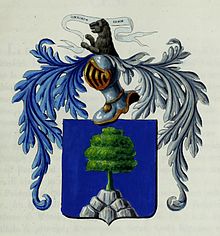
Borgo is the 14th rione of Rome, Italy. It is identified by the initials R. XIV and is included within Municipio I.

The Via Giulia is a street of historical and architectural importance in Rome, Italy, which runs along the left (east) bank of the Tiber from Piazza San Vincenzo Pallotti, near Ponte Sisto, to Piazza dell'Oro. It is about 1 kilometre long and connects the Regola and Ponte Rioni.

Via della Conciliazione is a street in the Rione of Borgo within Rome, Italy. Roughly 500 metres (1,600 ft) in length, it connects Saint Peter's Square to the Castel Sant'Angelo on the western bank of the Tiber River. The road was constructed between 1936 and 1950, and it is the primary access route to the Square. In addition to shops, it is bordered by a number of historical and religious buildings – including the Palazzo Torlonia, the Palazzo dei Penitenzieri and the Palazzo dei Convertendi, and the churches of Santa Maria in Traspontina and Santo Spirito in Sassia.
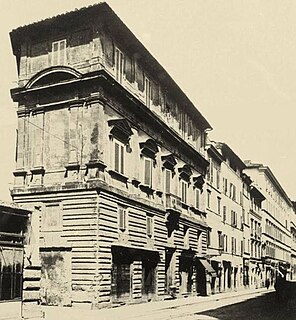
Palazzo Jacopo da Brescia was a Renaissance palace in Rome, Italy, which was located in the Borgo rione.
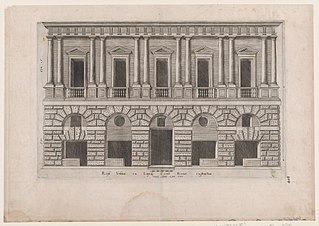
Palazzo Caprini was a Renaissance palazzo in Rome, Italy, in the Borgo rione between Piazza Scossacavalli and via Alessandrina. It was designed by Donato Bramante around 1510, or a few years before.
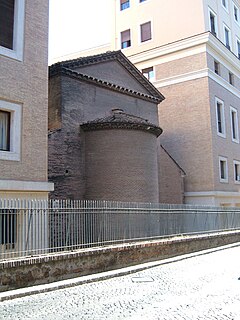
The Church of San Lorenzo in Piscibus is a 12th-century small church in the Borgo rione of Rome. It is located near Saint Peter's Square and Vatican City, but its façade is not visible from the main street, Via della Conciliazione.

Palazzo Serristori is a Renaissance building in Rome, important for historical and architectural reasons. The palace is one of the few Renaissance buildings of the rione Borgo to have outlived the destruction of the central part of the neighborhood due to the building of Via della Conciliazione, the grand avenue leading to St. Peter's Basilica.

Palazzo dei Convertendi is a reconstructed Renaissance palace in Rome. It originally faced the Piazza Scossacavalli, but was demolished and rebuilt along the north side of Via della Conciliazione, the wide avenue constructed between 1936 and 1950, which links St Peter's Basilica and the Vatican City to the centre of Rome. The palace is famous as the last home of the painter Raphael, who died there in 1520.
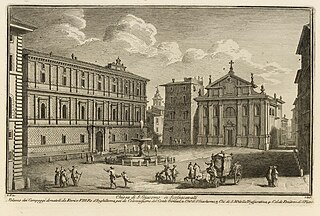
San Giacomo Scossacavalli was a church in Rome important for historical and artistic reasons. The church, facing the Piazza Scossacavalli, was built during the early Middle Ages and since the early 16th century hosted a confraternity which commissioned Renaissance architect Antonio da Sangallo the Younger to build a new shrine. This was richly decorated with frescoes, painted by mannerist artist Giovanni Battista Ricci and his students. The church was demolished in 1937, when Via della Conciliazione was built and the piazza and central part of the Borgo rione were demolished. Many decorative elements still exist, since they were preserved from demolition.

Palazzo Alicorni is a reconstructed Renaissance building in Rome, important for historical and architectural reasons. The palace, originally lying only a few meters away from Bernini's Colonnades in St. Peter's square, was demolished in 1931 in the wake of the process of the border definition of the newly established Vatican City state, and rebuilt some hundred meters to the east. According to the stylistic analysis, his designer had been identified as Giovanni Mangone, a Lombard architect active in Rome during the 16th century.
Cristoforo Ambrogini was an Italian painter active in Rome in the late 16th - early 17th century. His only known works are the frescoes on the facade of the church of San Giacomo Scossacavalli in Rome, and those on the walls and the vault of the first chapel of the right nave in the same church. The chapel was restructured in 1600 by architect Antonio Longhi and was thereafter decorated by Ambrogini. San Giacomo was destroyed in 1937 for the erection of Via della Conciliazione.

The Palazzo Rusticucci-Accoramboni is a reconstructed late Renaissance palace in Rome. Erected by the will of Cardinal Girolamo Rusticucci, it was designed by Domenico Fontana and Carlo Maderno joining together several buildings already existing. Due to that, the building was not considered a good example of architecture. Originally lying along the north side of the Borgo Nuovo street, after 1667 the building faced the north side of the large new square located west of the new Saint Peter's Square, designed in those years by Gian Lorenzo Bernini. The square, named Piazza Rusticucci after the palace, was demolished in 1937–40 because of the erection of the new Via della Conciliazione. In 1940 the palace was dismantled and rebuilt with a different footprint along the north side of the new avenue, constructed between 1936 and 1950, which links St Peter's Basilica and the Vatican City to the center of Rome.
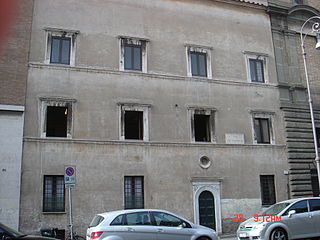
The House di Febo Brigotti is a Renaissance house located on Via dei Corridori 44, in the Borgo rione of Rome.

Borgo Nuovo, originally known as via Alessandrina, also named via Recta or via Pontificum, was a road in the city of Rome, Italy, important for historical and architectural reasons. Built by Pope Alexander VI Borgia for the holy year of 1500, the road became one of the main centers of the high Renaissance in Rome. Borgo Nuovo was demolished together with the surrounding quarter in 1936–37 due to the construction of Via della Conciliazione.

Borgo Vecchio, also named in the Middle Ages Via Sancta, Carriera Sancta or Carriera Martyrum, was a road in the city of Rome, Italy, important for historical and architectural reasons. The road was destroyed together with the adjacent quartier in 1936–37 due to the construction of Via della Conciliazione.

Piazza Scossacavalli, also named Piazza di San Clemente, Piazza di Trento, Piazza d'Aragona, Piazza Salviati, was a square in Rome, Italy, important for historical and architectonic reasons. The square was demolished together with the surrounding quarter in 1937 due to the construction of Via della Conciliazione.

The Palazzo del Governatore di Borgo, also called Palazzo delle Prigioni di Borgo, Palazzo del Soldano, or Palazzo dal Pozzo, was a Renaissance palace in Rome, important for artistic and historical reasons. Designed by Antonio da Sangallo the Younger, it was demolished in 1936 for the opening of Via della Conciliazione.

Santa Maria della Purità was a church in Rome, important for historical and artistic reasons. Consecrated between 1530 and 1538, the building was demolished together with the surrounding district in 1937-40 during the works for the opening of via della Conciliazione.

San Michele Arcangelo ai Corridori di Borgo was a church in Rome dedicated to St. Michael, the Archangel, important for historical and artistic reasons.

Borgo Santo Spirito is a street in Rome, Italy, important for historical and artistic reasons. From a historical point of view, it is considered the most interesting street in the Borgo district. Of medieval origin, it is linked to the foundation of the ancient fortified hospice for pilgrims from England, the Burgus Saxonum. The street houses the oldest Roman hospital, the Arcispedale di Santo Spirito in Saxia, which gave it its name. Heavily altered during the works for the opening of Via della Conciliazione, it nevertheless avoided the fate of the two parallel streets of Borgo Nuovo and Borgo Vecchio, both destroyed.


